Are you trying to access another PC remotely, but not sure which software to use? In this case, you may want to enable the Remote Desktop Connection in Windows 11/10. It’s a built-in feature that helps you connect to other computers remotely.
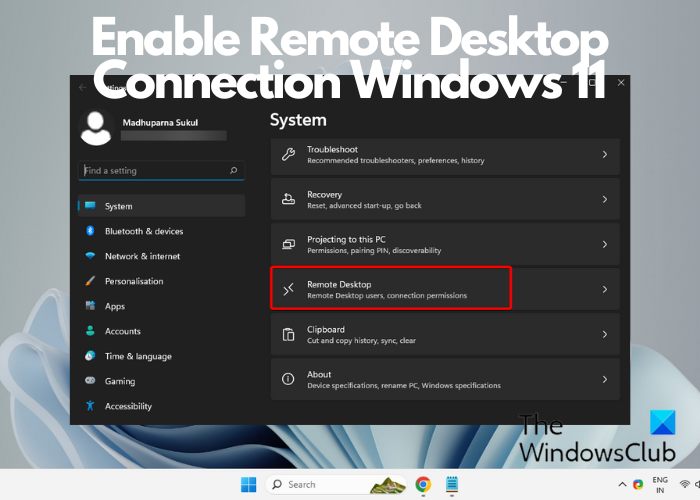
While there is umpteen free remote access software available online, you may instead take advantage of the built-in support, which is equally efficient and works over the network.
What does a Remote Desktop connection do?
The Remote Desktop Connection helps users to connect to a desktop computer located at a different location from a separate device and even use it remotely. This feature allows you to easily access your desktop, run applications, and even edit files remotely just like you would do when physically present at your computer. It helps users to boost productivity and facilitate remote work.
How to enable Remote Desktop Connection in Windows 11
There are eleven ways using which you can enable and open the Remote Desktop Connection in Windows 11/10:
- Through Windows Settings
- Using the Control Panel
- Using the Windows Search bar
- Via the Run console
- Through the Command Prompt
- Using the File Explorer
- Through the Start menu
- Using the Task Manager
- By creating a desktop shortcut
- Using a hotkey
- By adding a shortcut to the content menu
1] Through Windows Settings
In Windows 11
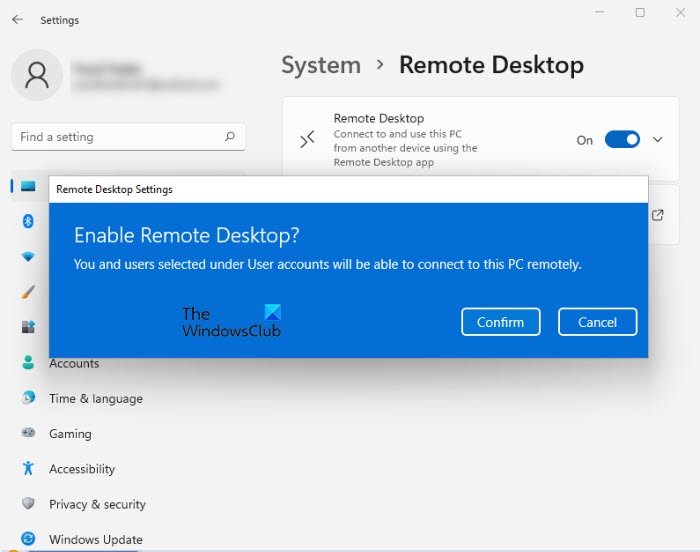
You can follow the instructions below to enable Remote Desktop on Windows 11 through Settings:
- Launch Windows Settings (Win + I) and click on System on the left.
- Next, click on Remote Desktop on the right.
- On the next screen, move the toggle switch to the right to enable Remote Desktop.
- Press the Confirm button to save the changes.
This is how you can use Windows 11 Settings to enable Remote Desktop.
In Windows 10
This procedure is for people who use Windows 10. Go to the Start Menu and tap the cogwheel to launch Settings. Alternatively you could press ‘Windows + I’ keys to open Windows Settings. Next, go to ‘System’ from ‘Settings’ and find the ‘Remote Desktop’ option at the left in System. Click it and wait for the ‘Remote Desktop’ page to load.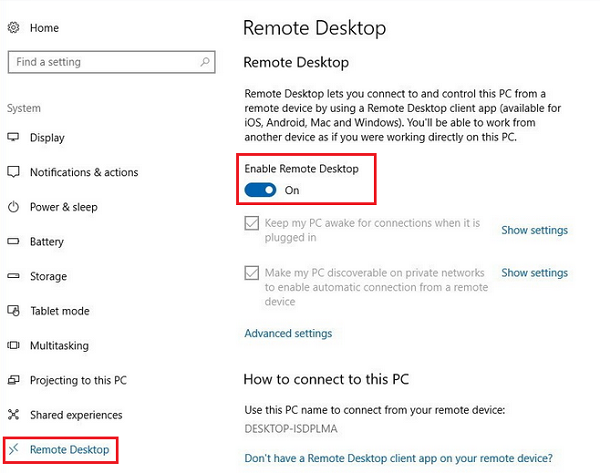
A prompt will appear. Click Yes.

Once you do this, you will see additional settings appear:
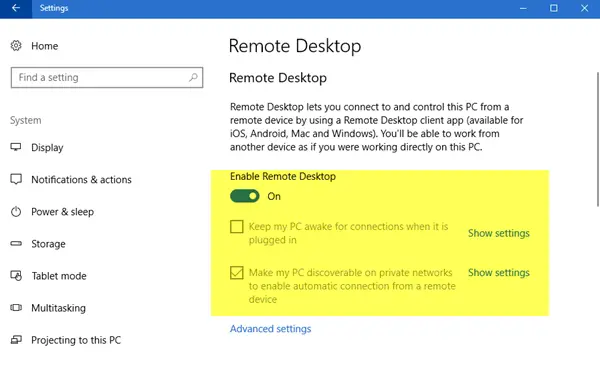
You can configure your options for the following settings:
- Keep my PC awake for connections when it is plugged in
- Make my PC discoverable on private networks to enable automatic connection from a remote device
If you need more options, click on Advanced settings.
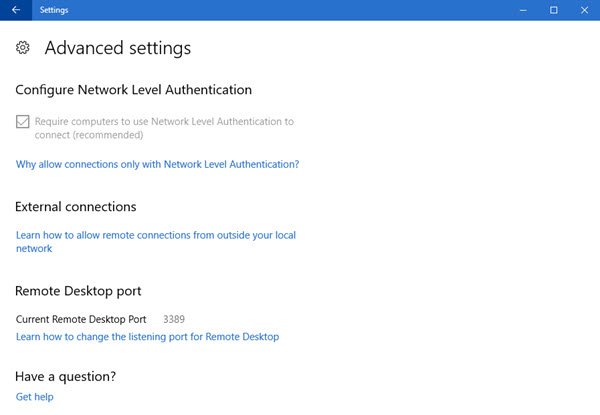
Here, you will see some additional settings that you can configure.
Note: Ever since Remote Desktop Client 6.0, Remote Desktop Connections only work with Network Level Authentication. If you don’t want to share admin credentials, go to the Remote Desktop Settings and click ‘Select users that can remotely access this PC’ and customize for yourself. There are options to get rid of this restriction too though.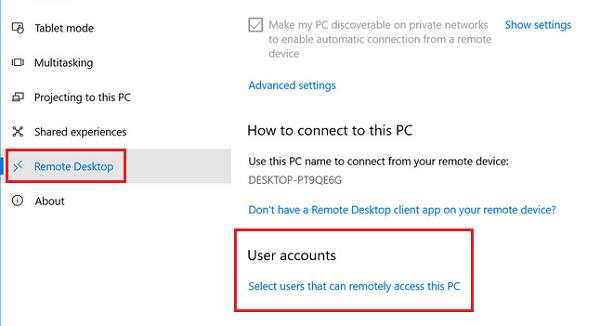
Don’t forget to click ‘OK’ at the end of everything in order to enable Remote Desktop Connection.
Read: How to enable Remote Desktop without Password in Windows
2] Using Control Panel
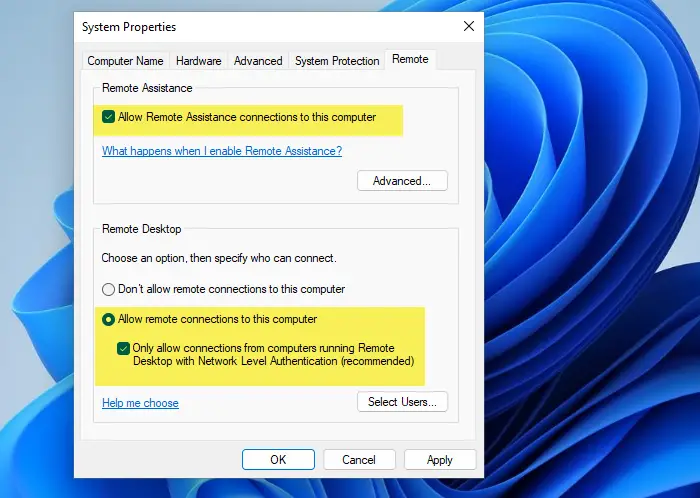
Another way to enable the Remote Desktop Connection is by using Control Panel. All you need to do is to open Run console (Win + R) > type Control > Enter > Control Panel > System and Security >System > Allow remote access > Remote tab > check the box next to Allow Remote Assistance connections to this computer and Allow Remote Connections to this computer > Apply > OK.
3] Using the Windows search bar
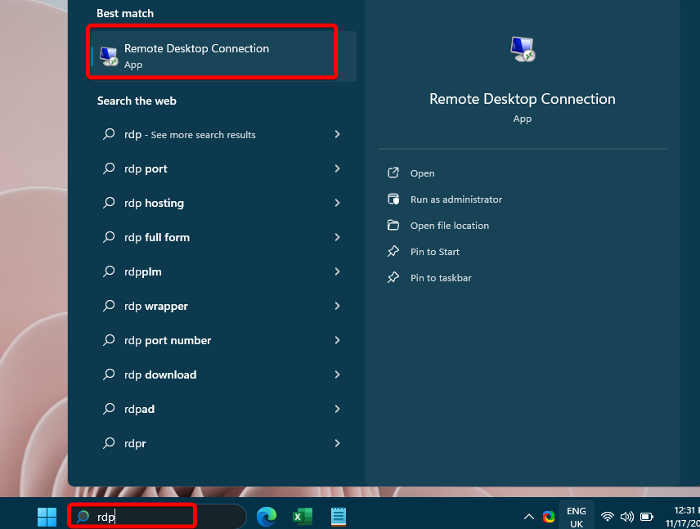
Alternatively, you can navigate to the Windows search bar and type RDP. Under Best Match, click on Remote Desktop Connection to open the app. Next, you can enter the computer name or select one from the drop-down and press Connect. You would then need to enter the credentials after you connect, and you can use the Microsoft Remote Desktop utility.
4] Via the Run console
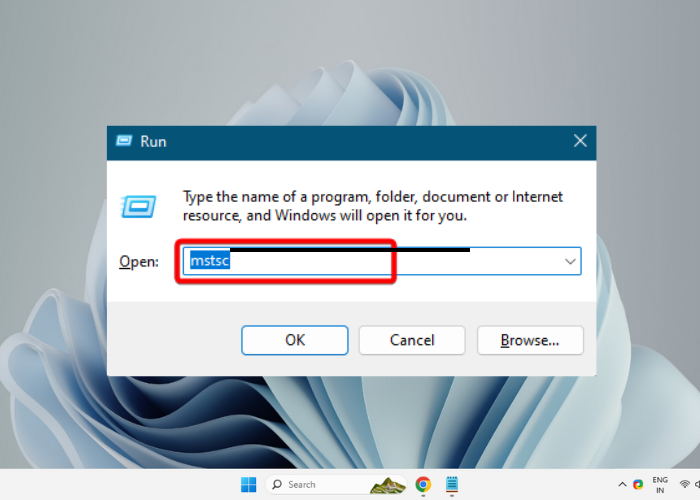
If you are comfortable using the Run console, press the Win + R to open the Run box. Now, type in mstsc in the search box and hit Enter. This will enable the Remote Desktop Connection on your Windows 11 PC.
Read: How to use Remote Desktop in Windows Home (RDP)
5] Through the Command Prompt
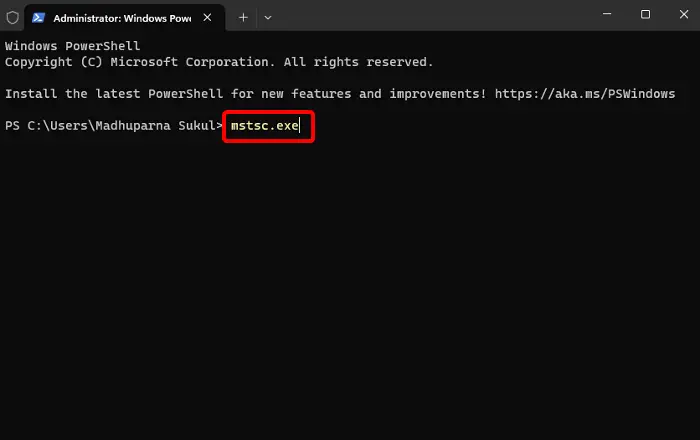
Besides, you can also enable Remote Desktop using Command Prompt or PowerShell. All you need to do is launch the elevated Command Prompt, run mstsc.exe, and hit Enter. It will open the Remote Desktop Connection. Alternatively, you can open Windows PowerShell in admin mode, type in mstsc, and hit Enter to enable RDP.
6] Using the File Explorer
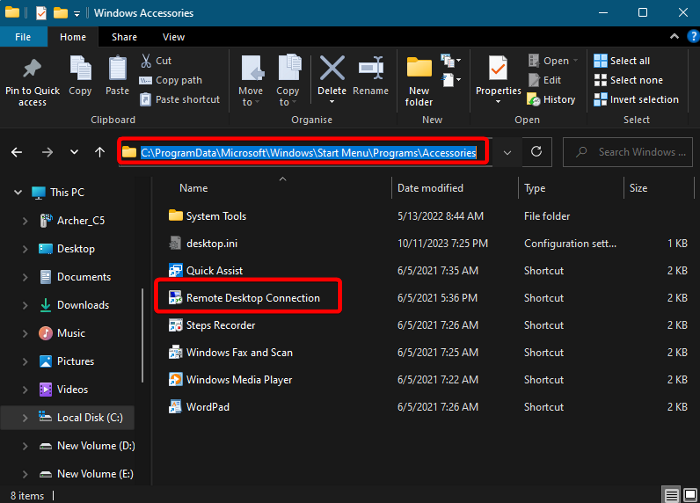
The Windows Accessories folder is the apparent folder for the Remote Desktop Connection and hence, you can open RDP from this folder. For this, press Win + E shortcut keys to launch the File Explorer. Now, navigate to the below path:
C:\ProgramData\Microsoft\Windows\Start Menu\Programs\Accessories
Double-click on Remote Desktop Connection to open the app on Windows 11 and enable it.
7] Through the Start menu
Alternatively, click on the Start menu and click on All Apps. Next, scroll down and click on Windows Tools. Once this folder opens, click on Remote Desktop Connection to open the app.
Read: How to add or remove Remote Desktop users in Windows
8] Using the Task Manager
To use Microsoft Remote Desktop, you can enable it through the Task Manager. For this, right-click on the taskbar and select Task Manager. Next, click on File and select Run new task. In the Create new task console, type in mstsc and hit Enter to open RDP.
9] By creating a desktop shortcut
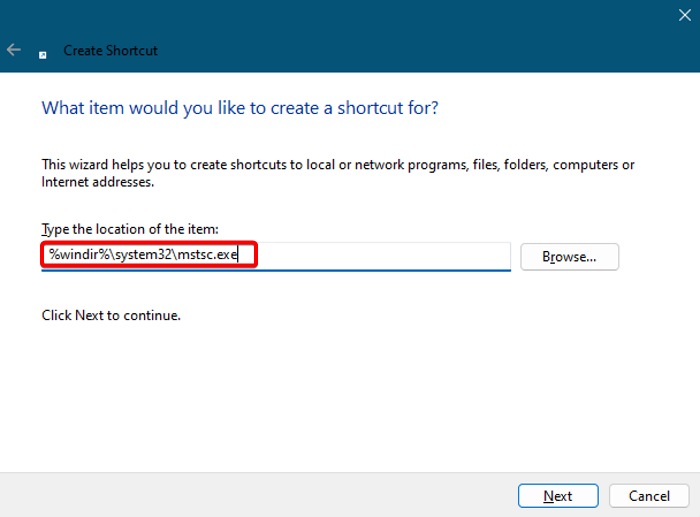
If you are looking for a quicker way to enable the Remote Desktop Connection or any other software, create a desktop shortcut for RDP. For this, right-click on an empty area in the desktop > New > Shortcut > Create Shortcut window > type %windir%\system32\mstsc.exe > Next > name it Remote Desktop Connection > Finish.
Now, double-click on the shortcut to open and use Microsoft Remote Desktop.
10] Using a hotkey
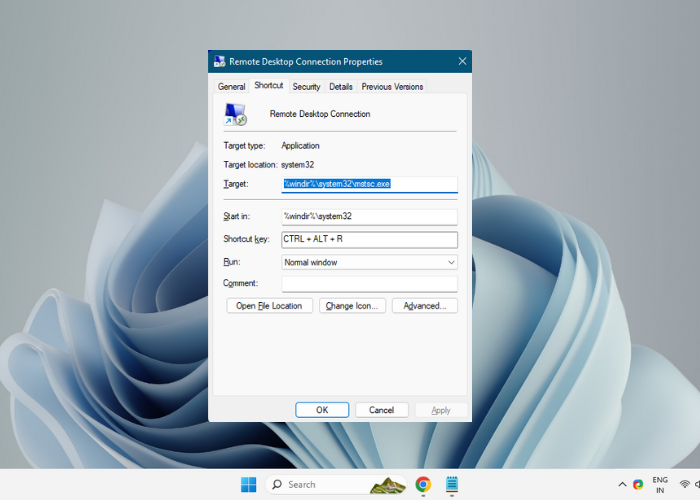
Once you have successfully created the desktop shortcut for Remote Desktop connection, you can then add the shortcut key. Here’s how:
Right-click on the Remote Desktop Connection shortcut and select Properties.
Now, select the Shortcut tab, and click inside the Shortcut key field.
Now, hit the R key on your keyboard and it will create the hotkey (Ctrl + Alt + R) for Remote Desktop Connection. But make sure, you do not delete the desktop shortcut because it’s required for the hotkey to work.
11] By adding a shortcut to the context menu
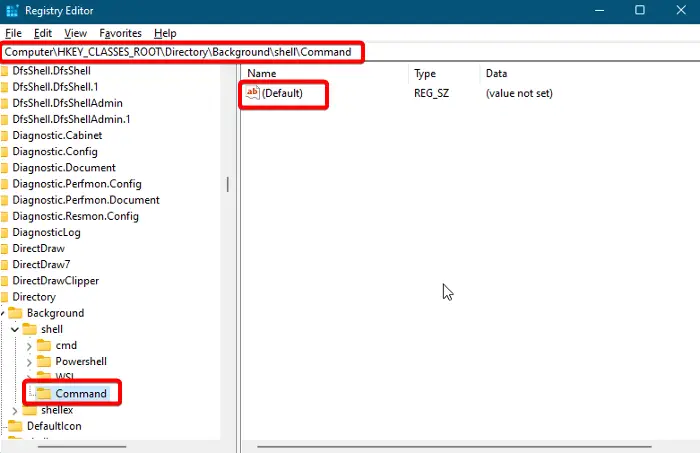
You can also add the shortcut to open the Remote Desktop Connection to the right-click context menu of the desktop. All you need to do is to edit the registry settings. However, before that, make sure you create a backup of the registry editor to restore any lost settings later if needed.
Now, launch the Run console (Win + R), type regedit and hit Enter to open the Registry Editor.
Next, navigate to the below path in the Registry Editor:
Computer\HKEY_CLASSES_ROOT\Directory\Background\shell\
Now, right-click on the Shell folder, select New > Key > Remote Desktop Connection.
Next, right-click on Remote Desktop Connection > New > Key > name the key as Command.
Now, go to the right, right-click on the Default string and select Modify.
In the Value data field, type C:\Windows\System32\mstsc and press OK to save the changes.
You will now see the shortcut for Remote Desktop Connection in the right-click context menu of the desktop. You can open the app from here.
Now read: How to use Remote Desktop to connect to another computer over the internet
Why can’t I connect to Remote Desktop on Windows 11?
If you can’t connect to Remote Desktop Connection on Windows 11, it could be either due to the antivirus or Windows Firewall blocking the app. Or it could be possible that you do not have the permission to log in via RDP. In such cases, while you can restart both the devices to resolve the issue, you can also turn off the antivirus or the firewall temporarily. Additionally, you can try connecting using the computer’s full name or IP address.
How do I enable multiple remote desktops in Windows 11?
To open multiple remote desktop connections, you must enable RDP for multiple users on Windows 11. For this, you would need to modify the termserv.dll file or use a third-party utility like the RDP wrapper. However, make sure you back up the termserv.dll file before you modify it. Enabling multiple RDP sessions allows you to access and control multiple connections simultaneously while it boots overall productivity.